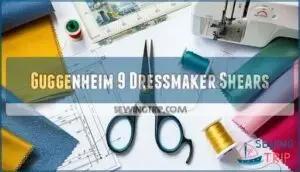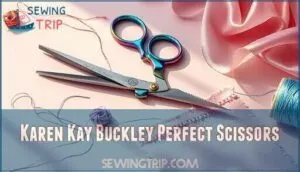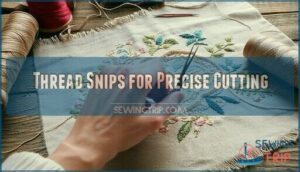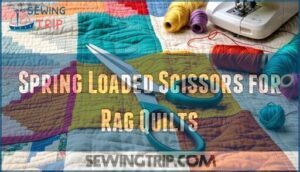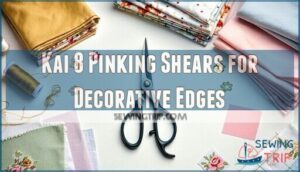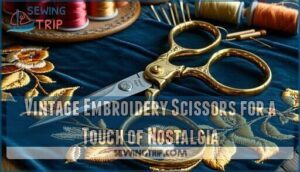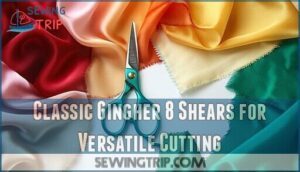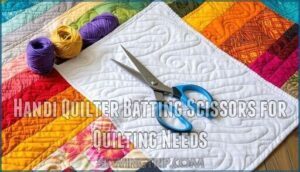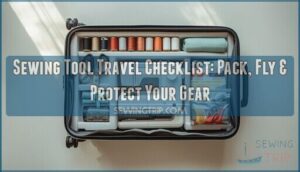This site is supported by our readers. We may earn a commission, at no cost to you, if you purchase through links.
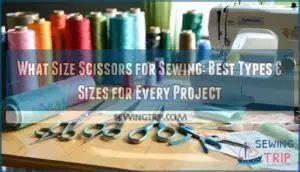 You’ll need different sizes depending on what you’re cutting. For most fabric work, 8-10 inch shears are your workhorses – they’ll handle everything from cotton to lightweight wool with ease. Think of them as the reliable friend who never lets you down.
You’ll need different sizes depending on what you’re cutting. For most fabric work, 8-10 inch shears are your workhorses – they’ll handle everything from cotton to lightweight wool with ease. Think of them as the reliable friend who never lets you down.
Smaller 4-6 inch embroidery scissors tackle detailed work like trimming seam allowances or cutting around curves. **Your hand size matters too; if those full-sized shears feel like wielding a sword, compact 6-inch scissors might be your sweet spot.
**
**Thread snips with 3-4 inch blades are perfect for precision work around buttonholes.
The secret lies in matching blade length to task complexity and fabric thickness.
Table Of Contents
- Key Takeaways
- Deciding Between Shears and Scissors
- Guggenheim 9 Dressmaker Shears
- Karen Kay Buckley Perfect Scissors
- Thread Snips for Precise Cutting
- Spring Loaded Scissors for Rag Quilts
- Kai 8 Pinking Shears for Decorative Edges
- Double Curved Machine Embroidery Scissors
- Vintage Embroidery Scissors for a Touch of Nostalgia
- Classic Gingher 8 Shears for Versatile Cutting
- Handi Quilter Batting Scissors for Quilting Needs
- Frequently Asked Questions (FAQs)
- Conclusion
Key Takeaways
- Match scissor size to your project needs – You’ll want 8-10 inch shears for general fabric cutting, 4-6 inch scissors for detailed work, and 3-4 inch thread snips for precision tasks like buttonholes.
- Consider your hand size when choosing scissors – If full-sized shears feel unwieldy, you’ll find compact 6-inch scissors more comfortable and give you better control during cutting sessions.
- Choose blade length based on fabric thickness and complexity – You’ll need longer, sturdy blades for heavy materials like denim and multiple layers, while shorter blades work better for curves and intricate cuts.
- Invest in quality scissors matched to your specific tasks – You’ll transform your sewing experience from frustrating to smooth when each tool serves its intended purpose, from heavyweight tailor shears to delicate embroidery scissors.
Deciding Between Shears and Scissors
When choosing between sewing scissors and shears, size makes all the difference in your cutting game. Shears usually measure 8-10 inches and feature longer blades that slice through multiple fabric layers like butter. Their ergonomic grips reduce hand fatigue during marathon cutting sessions. Regular scissors are shorter, usually 4-6 inches, perfect for detailed work and intricate cutting techniques.
Consider fabric thickness when deciding. Heavy materials like denim demand sturdy tailor shears with strong scissor blade material, while delicate silks work beautifully with lighter dressmaker shears. Pinking shears create decorative edges that prevent fraying. For thread work, embroidery scissors offer precision control.
Your hand size matters too. Larger hands benefit from full-sized shears, while smaller hands find comfort in compact scissors. Remember, proper scissor maintenance keeps both types performing at their peak. Quality ergonomic grips prevent cramping during extended projects. Ensuring sharp blade longevity is vital for achieving clean cuts and extending the life of your scissors.
Guggenheim 9 Dressmaker Shears
Professional sewers swear by these heavy-duty performers for good reason. The Guggenheim 9 dressmaker shears deliver outstanding fabric cutting through their precision-ground stainless steel blades and sturdy construction. With their 9-inch length, you’ll breeze through large pattern pieces and multiple fabric layers with impressive sewing efficiency.
- Ergonomic Grips: Metal construction provides durability, though some users prefer cushioned grips for extended sessions
- Blade Sharpness: Factory-ground edges maintain cutting precision through years of regular dressmaking projects
- Heavy-Duty Performance: Cuts smoothly through thick upholstery, wool, and multiple denim layers without hand strain
- Scissor Maintenance: Lifetime warranty backs consistent performance when you follow proper fabric-only cutting practices
These tailor shears transform challenging cuts into smooth slices. For ideal results, choosing the right sewing scissors for your specific sewing needs is vital.
Karen Kay Buckley Perfect Scissors
Karen Kay Buckley Perfect Scissors come in six sizes from 4" to 8.5", giving you options for every sewing project. Made from Japanese high-carbon steel, these scissors maintain blade sharpness for years. The micro-serrated blades grip fabric like tiny teeth, preventing slippery materials from sliding during cuts.
The ergonomic grips feature soft cushioning that fits both right and left hands comfortably. They’re perfect for appliqué work and detailed fabric cutting, slicing through multiple layers without fraying edges.
At $35-37, they’re pricier but deliver professional cutting techniques that’ll make your quilting projects sing. For more information on these high-quality scissors and other quilting tools, visit the website for quilting products and resources.
Thread Snips for Precise Cutting
Thread snips are your go-to tool when you need surgical precision in tight spaces. These specialized sewing scissors excel at Thread Cutting around buttonholes and detailed embroidery work.
Key features to examine:
- Sharp, fine-pointed tips for intricate Cutting Techniques
- Lightweight design for extended Fabric Handling sessions
- Spring-loaded action that reduces hand fatigue
- Compact size perfect for close-quarters work
- Durable stainless steel blades requiring minimal Snip Maintenance
Unlike bulky embroidery scissors or small fabric scissors, thread snips offer superior control. Their Precision Tips let you trim threads flush against fabric without accidentally snipping your project. Keep them handy at your sewing station—you’ll reach for these workhorses constantly. Mastering the use of thread snips involves understanding the importance of sharp blade materials for achieving professional results.
Spring Loaded Scissors for Rag Quilts
Why struggle with hand cramps when spring loaded scissors can transform your rag quilting experience? These quilting essentials automatically pop open after each cut, reducing fatigue during those marathon clipping sessions every 1/8 inch along seam allowances.
The ergonomic grips fit various hand sizes comfortably, while precision-ground stainless steel blades slice through six to twelve fabric layers effortlessly. Top rag quilt tips include choosing brands like Heritage or Fiskars for reliable spring action and high-quality sewing efficiency.
Proper scissor maintenance keeps these quilting tools sharp for countless projects ahead. Using the right fabric cutting tools is essential for achieving professional-looking results in sewing projects.
Kai 8 Pinking Shears for Decorative Edges
The Kai 8 Pinking Shears transform ordinary fabric cutting into an art form with their distinctive zigzag edge finishing capabilities. These 8-inch fabric shears feature hardened AUS6A stainless steel blades that slice through multiple layers effortlessly.
- Professional Construction: Vanadium steel alloy blades with 56±1 HRC hardness rating guarantee long-lasting performance
- Ergonomic Design: Soft grip controls minimize hand fatigue during extended decorative trimming sessions
- Precision Control: Adjustable brass tension screw maintains precise cutting accuracy for various sewing techniques
Whether you’re preventing fraying on woven fabrics or adding decorative touches to craft projects, these Japanese-made pinking shears deliver smooth, consistent results. Their balanced weight and ergonomic comfort make scissor maintenance simple while providing the durability professionals demand. To achieve the best results, understanding pinking shear techniques is essential for any sewing or crafting project.
Double Curved Machine Embroidery Scissors
Double curved machine embroidery scissors offer game-changing curved blade benefits for precise embroidery techniques. These 6-inch sewing scissors feature ergonomic grips that lift your hand over hoop edges, preventing accidental fabric snips. The double curve design allows neutral wrist positioning while trimming embroidery thread without removing projects from machines.
Choose models with precision-ground tips and chrome-over-nickel construction for durability. Proper scissor maintenance includes using these sewing tools only on fabric. These machine embroidery tips guarantee 90% faster thread cutting compared to straight scissors.
When selecting the best sewing scissors, consider the importance of high carbon steel for long-lasting sharpness and clean cuts.
Vintage Embroidery Scissors for a Touch of Nostalgia
You’ll fall in love with vintage embroidery scissors that blend sewing heritage with practical functionality. These antique collecting treasures, often featuring ornate grips and precision-ground blades, excel at thread cutting and detailed embroidery techniques.
Small fabric scissors from brands like Gingher or Wiss showcase embroidery history through their craftsmanship. You’ll find these embroidery supplies perfect for intricate work where modern tools feel too clinical. Their 3-4 inch length provides excellent control for delicate embroidery scissors tasks.
Proper care keeps these sewing scissors sharp—clean gently and store dry to preserve their vintage charm and cutting performance. When choosing the best sewing scissors, consider the importance of high quality blades for achieving clean cuts and preventing fabric tears.
Classic Gingher 8 Shears for Versatile Cutting
When you need dressmaker shears that excel across various fabrics, Gingher’s 8-inch shears deliver outstanding performance. These precision-ground knife-edge blades cut multiple layers effortlessly, while bent grips provide comfort during extended use. The scissor blade material features forged steel construction for lasting sharpness.
Key features include:
- Ergonomic grip design reduces fatigue during long cutting sessions
- Cutting efficiency improves with the longer blade length
- Sewing precision comes from the knife-edge blade technology
- Fabric durability testing ensures consistent performance across materials
These adaptable dressmaker shears bridge the gap between basic sewing scissors and specialized tools like pinking shears or embroidery scissors, making them perfect for general fabric cutting tasks. The longevity of Gingher scissors is due to their high-quality stainless steel construction, which ensures they remain sharp and effective over time.
Handi Quilter Batting Scissors for Quilting Needs
When you’re wrestling with thick batting layers, the Handi Quilter Batting Scissors become your secret weapon. These specialized quilting scissors feature 5-inch straight-edge blades that slice cleanly through lofty polyester, wool, cotton, and bamboo batting without the frustration of snagging.
The offset ergonomic handle design keeps your hand comfortable during marathon cutting sessions—a real blessing if you’ve got arthritis or grip challenges. You’ll glide along flat surfaces without lifting, making those long, continuous cuts feel smooth. At just 0.6 pounds, these batting cutters won’t weigh you down.
Unlike regular fabric shears or dressmaker shears, these quilter tools handle multiple batting layers simultaneously. The blunt, rounded tips prevent catching on dense materials, giving you straighter cuts every time. While pinking shears and embroidery scissors have their place in your sewing accessories collection, these specialized quilting blades tackle what other sewing scissors can’t—thick, stubborn batting that laughs at standard tools. Choosing the right scissors also involves understanding the importance of sharpness maintenance to guarantee clean cuts and prolong the life of your scissors.
Frequently Asked Questions (FAQs)
Are Kai scissors available in left-handed versions?
Southpaws can finally break free from cutting challenges! Yes, Kai offers several true left-handed scissors including the N5220L (5"), N5210L (8"), and 7250L (10") with ergonomic grips and reversed blades.
How often do Kai scissors need to be sharpened?
You’ll usually need Kai scissors sharpened every 6-12 months with regular use. Professional maintenance at least once yearly keeps them performing optimally.
Heavy daily use might require more frequent attention.
Where can I purchase Kai scissors?
Over 85% of sewers shop online for premium scissors. You’ll find authentic Kai scissors at their official website, Amazon, WAWAK, Scissorman USA, and specialty sewing retailers like Tacura for guaranteed quality and warranty coverage.
What blade length works best for cutting curves?
You’ll want 4-6 inch blades for smooth curves. Shorter blades give you better control and maneuverability around tight turns.
Your fabric scissors become an extension of your hand, dancing gracefully through curved seams.
How do handle sizes affect cutting control?
Ever wonder why your hand cramps during long cutting sessions? Larger grips provide better grip distribution, reducing fatigue and giving you steadier control.
Smaller grips work fine for quick snips but can strain your fingers during extended fabric cutting projects.
Should beginners start with smaller or larger scissors?
Start with smaller scissors around 4-5 inches. They’re easier to control, less intimidating, and perfect for learning proper cutting techniques.
You’ll build confidence before graduating to larger shears for bigger projects.
What weight scissors reduce hand fatigue most?
Lightweight titanium or aluminum-held scissors reduce hand fatigue most effectively. Heavy steel grips tire your hands quickly during extended sewing sessions. You’ll find these materials cut your workload while maintaining precision.
Which size cuts through multiple fabric layers easily?
You’ll need 8-10 inch dressmaker or tailor shears for multiple layers. Their longer blades and sturdy construction slice through thick fabric stacks like butter, giving you clean cuts without hand strain.
Conclusion
Selecting scissors smartly starts with understanding your specific sewing needs. What size scissors for sewing depends on your project type, fabric weight, and hand comfort.
From 8-10 inch workhorse shears for general cutting to precise 3-4 inch thread snips for detailed work, each tool fulfills its purpose.
Investing in quality scissors matched to your tasks will transform your sewing experience from frustrating to exceptional.
- https://www.martellinotions.com/martelli-10-sewing-scissors.html
- https://proshearus.com/blogs/news/what-are-the-top-features-to-look-for-in-sewing-scissors
- https://www.diamondneedle.com/fabric-scissors-vs-regular-scissors
- https://www.wawak.com/cutting-measuring/scissors-by-use/
- https://easythingstosew.com/different-types-of-sewing-scissors/

